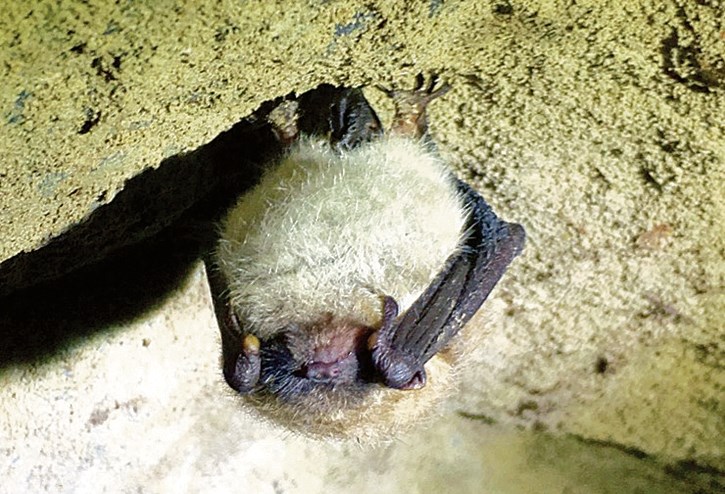BANFF – The river path from Banff Avenue to the Muskrat Street pedestrian bridge will not be lit at night amid several environmental concerns, including disturbance to the endangered little brown bat.
Instead of lighting the dark path at night, Town of Banff administration will create signage directing people to use other lit paths to get from downtown to such places as the Banff Centre and Banff Springs Hotel at night.
Town of Banff officials say Parks Canada impact assessment determination indicated that lighting for this section would be required to be dimmed by 60 per cent after 11 p.m., lighting turned off for a minimum of five hours per night and a consistently lower level of lighting than other lit sections of trail.
Amanda Arbuckle, manager of recreation services for the Town of Banff, said the reasons for these measures is due to the trail’s proximity to riparian environments that are home to species at risk, including the little brown bat.
“As a result of this, we are not recommending to light that trail because we don't think it will serve the intended need,” she said.
“We would look to update our existing trail signage and our pedestrian way-finding signage to direct folks to use a different route at times of darkness.”
The little brown bat is protected under Canada’s Species At Risk Act. The bat was one of three bats in Canada that was emergency listed as endangered in 2014 because of sudden and dramatic declines in population.
According to the Committee on the Status of Endangered Wildlife in Canada, (COSEWIC), white nose syndrome is the single greatest threat to the little brown bat. Other threats include habitat loss and degradation, such as hibernacula, maternity roosts, and foraging areas, as well as recreational disturbance, pollution, and climate change.
“Little brown myotis is likely the most common bat species in Canada and the most familiar of the three species to the public because they often use buildings as day-roosts and forage in areas where they are visible, for example, over lakes, around streetlights,” states COSEWIC’s assessment report.
Coun. Chip Olver was concerned people would continue using the convenient path regardless of whether or not there is lightning.
“I suspect lack of lights isn’t going to stop people from using it, because it’s such a convenient pathway even with our signage,” she said.
“I understand an impact assessment was done and came back. I just think it was a very popular usage, and that it will be disappointing for people, but I think they’ll continue to use it.”
Town Manager Kelly Gibson said signage would recommend against using the trail at night and put other routes as alternatives, but the trail won’t be closed to stop people from using the trail at night.
“Signage would help indicate the way to go,” he said.
“Often people will follow the lights so hopefully they won’t continue to do that at night time.”
While lightning this section of trail is now off the table, the Town of Banff is recommending lighting several other popular trails throughout town, including Glen Avenue-Spray Avenue and Antelope Lane-Tunnel Mountain Road.
The Town is also proposing to install lighting on the route between Bighorn Street and the train station intercept parking lot to deal with potential and perceived safety issues.
“We recognized that trail due to the seniors housing in the area and the nearby daycare and staff coming and going early, visitors coming and going at early or late hour,” said Arbuckle.
Also on the list is potentially lighting the trail between Cascade Gardens and Jasper Way.
“We recognize this is the shortest route and desire line for pedestrians between downtown and Middle Springs neighbourhoods,” she said.
With Parks Canada requiring an impact assessment on proposals to light these trails, administration will return to council’s annual review of municipal services later this year with updated costs and the status of the impact assessments.
On Monday, council also adopted its lightning policy, which acknowledges that all the trails previously identified for lighting may not be realistic due to potential negative human and environmental impacts and because nearby alternative lit routes may already be available.
The policy confines future trail lighting to projects that would support increased active commuting through increased safety, while also minimizing potential impacts to the nighttime environment. It also includes more generic guidelines for lighting fixtures.
“If there are alternative solutions to lighting, or adverse negative impacts are expected, do not light,” said Arbuckle.
Mayor Corrie DiManno voiced strong support for continuing down the path of lighting the other trails administration is recommending.
She said trail lighting is a factor when it comes to people not wanting to use active modes of transportation, particularly in winter.
“When you look at the map we have of currently lit paths, you can tell that the lighting has not been able to keep up with the pace of us developing and strengthening our amazing pedestrian and cycling ecosystem that we have built here. We need to start catching up,” she said.
“I totally can appreciate there’s an environmental sensitivity to the amount of light, and positioning of the light, but we certainly need to do our due diligence to explore these sections to see if trail lighting is possible in them.”
The mayor said Banff is working towards making it easier and safer to get around town without a vehicle, referencing the two pedestrian bridges, a 30-km/h town-wide speed limit and a rebate for e-bikes as some of the ways to encourage active commuting.
“All these amazing things help lead to folks making that mode shift and now we just need to create that environment to make sure that it’s safe for them,” she said.
Currently, there is $400,000 set aside for trail lighting improvements in the capital budget.



